The Moon might be older than scientists previously thought − a new study shines light on its history
A physicist, a chemist and a mathematician walk into a bar. It sounds like the start of a bad joke, but in my case, it was the start of an idea that could reshape how scientists think about the history of the Moon.
The three of us were all interested in the Moon, but from different perspectives: As a geophysicist[1], I thought about...

